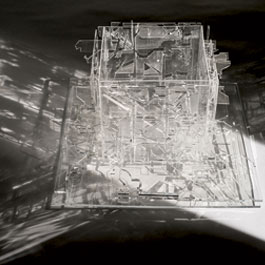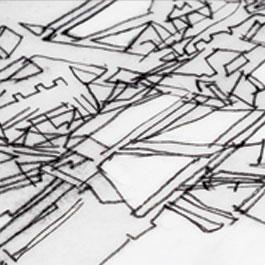Casting and Capturing Shadows

Anthony Viscardi engages shadows to generate form, asking the simple question, "If an object can cast a shadow, can a shadow cast an object?"
As a child, Anthony Viscardi tried to hide from his shadow. Today, he seeks them out. As a professor of art and architecture at Lehigh, Viscardi encourages his students to move beyond digital algorithms as they work to create humanly habitable space. He urges them to engage more dynamic processes of natural phenomena that ignite the imagination through experience and observation. A recurrent theme in Viscardi's pedagogy and professional work as an artist is the phenomenon of light and shadow as the progenitor of form.
Viscardi was drawn to light and shadow as relevant design and energy-conservation considerations early in his career while serving as partner and principal designer for an architectural design firm in Atlanta from 1979 to 1992. Subsequently, while teaching art and architecture at Georgia Tech, Morris Brown College and the Atlanta College of Art, he began to formulate a pedagogy that embraces the shadow as a means to generate form.
When Viscardi arrived at Lehigh in 1992, Ricardo Viera, professor of art and director and curator of Lehigh University Art Galleries, curated a solo exhibition of Viscardi's shadow work to introduce him to the community. Since that time, Viscardi's fascination with the shadow has proven to be an inexhaustible premise for inquiry, serving both his academic research and teaching as well as his personal work as an artist.

In speaking of his art, Viscardi says, "In essence, I steal the shadow of the object by tracing its outline, recording its form as it is transformed over time to create a sort of shadow map, from which I construct new objects or drawings."
For each piece, Viscardi constructs a three-dimensional model and intermittently traces its cast shadow to create a record of the sun's angular changes throughout one day. The design of the object is transformed over time as the ever-changing shadow directs. He employs a variety of techniques: For some drawings he traces the shadow using pencil on Mylar or ink on watercolor paper; for others, he employs airbrush. When finished, Viscardi discards the generative model—a work of art in and of itself—leaving only captured shadows, a record of how light interacted with an object in a certain place and time. He is currently exploring laser cutters, 3-D printing and CNC (computer numerical control) machines to inform his work.
Viscardi was awarded a coveted MacDowell Colony Fellowship to continue his visual investigations of shadow mapping during his 2011-12 academic sabbatical. The MacDowell Colony is the oldest artists' colony in the United States and has hosted the likes of Leonard Bernstein, Aaron Copeland and Milton Avery. Talent is the sole criterion for admission. Viscardi's experience at the MacDowell Colony, he says, helped to define him as a professional artist, independent from his role as an architect/academic.

In 2013, Viera curated Viscardi's second solo show at Lehigh to exhibit the MacDowell-based work. The Zoellner Gallery exhibition, "Tracing Time to Measure Space," drew one of the gallery's highest opening attendances ever.
Viscardi, whose work has been shown at galleries in New York, Philadelphia and numerous European cities, says he prefers not to begin a piece with preconceived ideas.
"There is something about the slow act of drawing and making small models that allows your mind to daydream and to meander," he explains, "and so connections are made, sometimes through mistakes, that aren't self-conscious or stereotypical." This is an advantage that modern technology doesn't always provide, he says.
It takes perseverance and dedication to make great architecture, Viscardi says, and he wants his students to embody that strong ethical stance. The same is true of his art.
"If you're going to make something, let it be meaningful," he says.
Anthony Viscardi is a nationally and internationally known scholar-teacher in the design and art of architecture. Viscardi spent the 2013-2014 academic year as Artist-in-Residence at Lafayette College’s Experimental Printmaking Institute, where his drawings assumed a new form through printmaking techniques such as collagraphy, etching, silkscreen and laser cutting. He received his master’s degree in architecture from the Georgia Institute of Technology.
Posted on:






